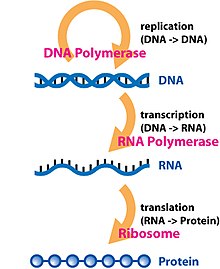
Back منطقة غير مترجمة Arabic Regió no traduïda Catalan Nepřekládaná oblast Czech Untranslatierte Region German Región no traducida Spanish UTR Basque نواحی ترجمه نشده Persian Région non traduite French UTR Galician אזור לא מתורגם HE


In molecular genetics, an untranslated region (or UTR) refers to either of two sections, one on each side of a coding sequence on a strand of mRNA. If it is found on the 5' side, it is called the 5' UTR (or leader sequence), or if it is found on the 3' side, it is called the 3' UTR (or trailer sequence). mRNA is RNA that carries information from DNA to the ribosome, the site of protein synthesis (translation) within a cell. The mRNA is initially transcribed from the corresponding DNA sequence and then translated into protein. However, several regions of the mRNA are usually not translated into protein, including the 5' and 3' UTRs.
Although they are called untranslated regions, and do not form the protein-coding region of the gene, uORFs located within the 5' UTR can be translated into peptides.[1]
The 5' UTR is upstream from the coding sequence. Within the 5' UTR is a sequence that is recognized by the ribosome which allows the ribosome to bind and initiate translation. The mechanism of translation initiation differs in prokaryotes and eukaryotes. The 3' UTR is found immediately following the translation stop codon. The 3' UTR plays a critical role in translation termination as well as post-transcriptional modification.[2]
These often long sequences were once thought to be useless or junk mRNA that has simply accumulated over evolutionary time. However, it is now known that the untranslated region of mRNA is involved in many regulatory aspects of gene expression in eukaryotic organisms. The importance of these non-coding regions is supported by evolutionary reasoning, as natural selection would have otherwise eliminated this unusable RNA.
It is important to distinguish the 5' and 3' UTRs from other non-protein-coding RNA. Within the coding sequence of pre-mRNA, there can be found sections of RNA that will not be included in the protein product. These sections of RNA are called introns. The RNA that results from RNA splicing is a sequence of exons. The reason why introns are not considered untranslated regions is that the introns are spliced out in the process of RNA splicing. The introns are not included in the mature mRNA molecule that will undergo translation and are thus considered non-protein-coding RNA.
- ^ Vilela, Cristina; McCarthy, John E. G. (2003-08-01). "Regulation of fungal gene expression via short open reading frames in the mRNA 5'untranslated region". Molecular Microbiology. 49 (4): 859–867. doi:10.1046/j.1365-2958.2003.03622.x. ISSN 0950-382X. PMID 12890013.
- ^ Barrett, Lucy W; Fletcher, Sue; Wilton, Steve D (2013). Untranslated Gene Regions and Other Non-Coding Elements. Springer. ISBN 978-3-0348-0679-4.
© MMXXIII Rich X Search. We shall prevail. All rights reserved. Rich X Search